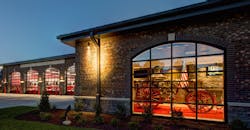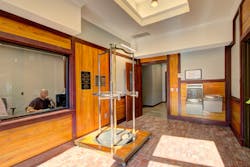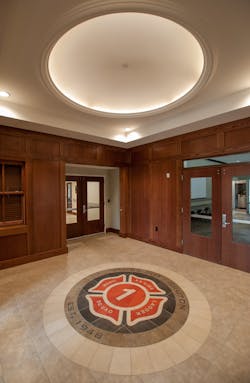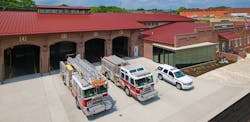I always have loved history. I can remember back to when I was a small child and every two weeks on Saturday, my dad and I would go to our small-town barber shop for our haircuts. I would be in the chair first, then my dad. When I got out of the chair, Dad would give me a dime to buy a soda pop in a glass bottle. I then spent most of the next 30 minutes staring at all of the old photographs, plaques and memorabilia that were on the walls and shelves. That barber shop served as somewhat of a museum in a town that was too small to have a dedicated museum. Many of the photos were of those who lost their life as members of the military or as public servants. I never have tired of learning about all of those who went before me.
After Sept. 11, 2001, the phrase “We will never forget” was reintroduced into American society with new vigor. As I have stated before on many occasions, it helps us to keep in mind those who went before us, many of whom lost their life in service to their nation or community.
History is important. There are many examples of nations, communities and even small groups that suffer the consequences of not remembering or recognizing their history. History reminds us of where we have been, and it shows us the good and bad in the past. History teaches us how we should live if we simply pay attention. It connects us with our earlier family members and friends and honors them for the sacrifices that they made to perform selfless acts.
As a public safety architect, I have spent the past four decades of my career providing fire station design services for some of the bravest, most honorable citizens in our communities. The firefighting community has a long history of service and sacrifice. Without question, every fire department has an impressive and important story to tell. As in the case of that old barber shop, many departments’ walls and shelves are full of photos, plaques, flags and other types of memorabilia. Unfortunately, many other departments haven’t considered or found effective ways to show their rich history to their community or even to their own members.
It’s key to make a department’s history well known, highly visible and inviting to all.Visible from the public way
Because its inclusion in a firehouse can further the distinction of the station, placing a museum or a memorial in a location that’s highly visible from the public way is a valuable approach. It can remind members of the community of the department’s history of service and act as an invitation to enter the station. Whether the museum or memorial is located outside of the station or on its interior, the display should allow the visitor to enjoy it in a safe environment while not hindering emergency responses. Although the size of the museum or memorial isn’t as critical as its location, the museum or memorial must be large enough to feature the department’s items of historical significance.
Most museums and memorials that are in stations are combined with the public lobby. Therefore, they are located on the public face of the station. This positioning allows for the opportunity to show off the department’s history, day or night, through properly sized and placed windows.
The recently completed Sumter, SC, Fire Department headquarters houses the department’s restored 1908 LaFrance fire steam engine in the museum/lobby along with other historical artifacts. Floor-to-ceiling windows show the museum pieces at all hours of the day. Because the museum is, in fact, the lobby, the public encounters the department’s history each time that they enter the station.Murals and large-scale vinyl graphics of historic photos on walls that are visible from the exterior can serve as cost-effective methods of telling a department’s history and to attract the public into display spaces. All interior opportunities are elements that can be lit well at night, which would make them visible during daytime hours, too.
Over the years when I spoke at the Station Design Conference or to department representatives directly, I urged people to remember that the design process of a significant project that contains a museum or specific historical emphasis, whether renovation or new construction, can benefit from the input from and collaboration with historical societies, architectural review boards and other such groups. Further, greater relationships with schools, local museums, chambers of commerce and others can emerge as an additional benefit.
Other interior elements
Numerous other interior elements can be used to display the department’s history. Display cases provide the opportunity to regularly rotate different pieces.
Department seals, logos and replica patches can be built, poured or recessed into a variety of floor finishes.
Retired fire poles can be displayed in public spaces or even set up for low-height slides in display areas for children.Historical displays aren’t just for visitors to the station. All of the elements can be used successfully in the private areas of the station, too. For instance, a retired fire pole can be repurposed for kitchen hanging racks or footrests at the kitchen bar.
Speaking of the kitchen, one of the ways to show off a department’s history and firefighters’ talent is to let them design and build a department-specific dining table. Make it a masterpiece!
A case study
When James City County, VA, dedicated the new James City-Bruton Volunteer Fire Department & Rescue Squad station, the facility became the third different building to occupy the same site over the past 110 years. The most recent previous building was the first Toano Fire Station, which was built in the mid-20th century. The original structure was the first public high school in James City County. Both of the earlier facilities served as significant gathering places for the members of the rural Toano community, situated at the midpoint along the roadway and railroad between the cities of Richmond and Hampton.
When it came time to replace the outdated fire station with a modern facility, the community was clear in its directives to Stewart-Cooper-Newell Architects, which teamed with architects of Guernsey Tingle, for the design to reflect the original, grand architecture of the historic Toano High School. Although some departments desire to attempt a replication of a previous fire station, the Toano community chose to pay aesthetic homage to a previous structure that wasn’t a fire station. Thankfully, old photographs of the two-story, early-20th century school still exist, which allowed the designers to study the structure details, replicate many building forms and provide a modern interpretation of the old aesthetic.The project illustrates how the integration of memorials, museums and historical content within a fire station can foster relationships, tell the story of a department and community, and honor the firefighting profession, all while being cost-effective. The exterior aesthetic features of the headquarters reflect design elements and principles that were found in the historic high school from a century earlier. There are many borrowed exterior details from the original school structure, such as roof forms, the window shapes and details, masonry detailing and the entry tower element. Although the station’s design language and materials are a reflection of the site’s former use, the tradition of the fire department and the history of the firefighting profession also are displayed proudly.
The station has zoned community space, such as a large community room and associated commercial kitchen, which results in a constant flow of visitors who encounter the historical aspects of the design as soon as they arrive. The wood-paneled, domed-ceiling entry lobby proudly displays the original fire department logo as inlaid tile flooring. Displays throughout the station feature historical firefighting equipment and technology that was used previously by the department.Community and member pride
Public safety departments do better when they have an active relationship with their community. Department representatives who are involved in the design of a new station or the renovation of an existing one would be remiss to not recognize how a museum or memorial can strengthen the relationship with the community—via encouraging interaction and facilitating education—which leads to generating trust.
Then there’s what a museum or memorial can mean to the active members of the department: They will see on a daily basis that the community never will forget those who sacrificed everything in the performance of their job.
There’s worth, too, regarding retired members, prompting reason to return to the station, where their pride in their previous service can be reinvigorated.
This article is part of the Station Design Supplement 2023. The entire supplement can be found here.
Site Elements
A memorial plaza can act as a place for visitors and department members to rest and reflect on the history of the department and those who served, or still are serving, the community. It doesn’t have to be a large area. Even the smallest of entryways or “off the beaten path” areas can house statues, plaques, flags, memorial benches, fountains, etc.
About the Author

Ken Newell
Since joining Stewart-Cooper-Newell Architects in 1988, Ken Newell, AIA, LEED AP BD+C, has earned a national reputation for the programming and design of award-winning public safety facilities that are functional, practical and budget-conscious. Newell was involved directly in the planning and design of more than 350 fire stations, EMS stations and public safety training facility projects that were designed by the firm. He also consulted other architects on the design of more than 75 public safety projects in 27 states. Many of these stations received national design award recognition. Since 2000, Newell has become one of the most in-demand presenters at national public safety design conferences. His unique ability to deliver high-quality and educational presentations, on very practical topics, has earned him top ratings from audiences.





